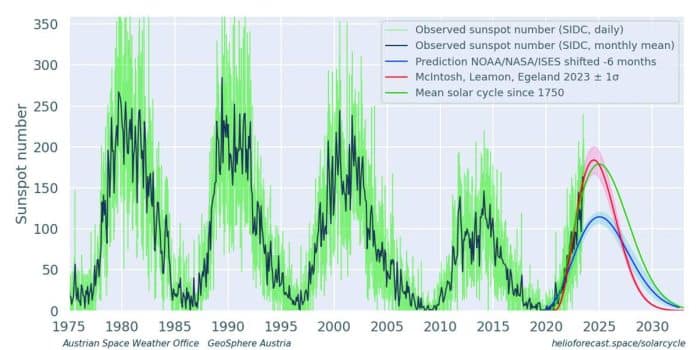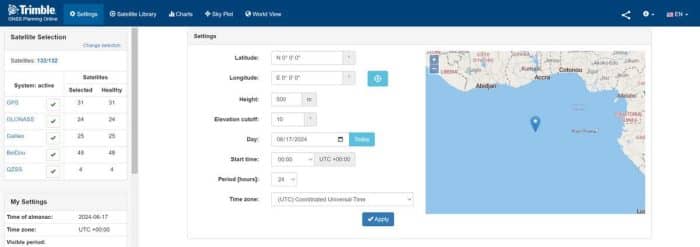Solar Sensations: Tips for Keeping Projects on Track During Solar Events

By now you’ve likely heard the term Solar Cycle 25 and listened with varying levels of interest and possibly concern. For many, it might seem like a lot of hype, and solely a concern for contractors with big machines working at higher latitudes. That’s true in many cases, but not always. If you use the global navigation satellite system (GNSS) in any way on your jobsites, and precision is important, then a raised awareness about Solar Cycle 25 is not just recommended, it’s essential.
A Flare of Unpredictability

The current 11-year solar cycle began in 2019 and is anticipated to peak between now and 2026. Events are already happening. In May, there was a significant solar storm that was the largest in over 20 years. It directly affected GNSS signals in North America.
Is this indicative of worse things to come? Possibly. The anticipated effects of this solar event are varied in both timing and severity, and are unpredictable. However, historical data suggests North America will see similar and perhaps more intense events over the next two years. Keep in mind that Solar Cycle 25 is expected to peak in 2025. Scientists don’t believe it will be as bad as the 2004 event, but possibly worse than 2014.
The Basics of Solar Activity

Ionospheric activity is correlated with the solar cycle. Towards the peak of the cycle, GNSS signals experience more delay through the ionosphere. There are two types of solar events: storm-based and ionospheric.
Geomagnetic storms originating from the sun create large disturbances in the atmosphere, as demonstrated by the event in May. We’ll see more frequent coronal mass ejections (CME) emitted from the sun during the peak of the solar cycle, which contain plasma with a magnetic field. If the CME is directed at the Earth, it can cause a geomagnetic storm on Earth around a day after it leaves the sun and can interact with the ionosphere causing instability, which can directly affect GNSS signals, resulting in high rates of change in delay. While temporary, event timing and severity are unpredictable.
Even multi-frequency/multi-system real-time kinematic (RTK) position solutions can be negatively impacted. At an extreme, the receiver may no longer deliver positions at full accuracy.
A second type of disturbance is seasonal ionospheric activity, a familiar condition for equatorial-based countries, such as Brazil. The equatorial ionospheric anomaly results in ionospheric scintillation from September through March, after sunset for three to five hours each night. These are more predictable than storm-based effects.
Solar storm-based or ionospheric events can degrade the accuracy and integrity of GNSS signals or even cause a complete loss of GNSS signals. The more heavy equipment — including skid steers, track loaders and mini excavators — that is equipped with GNSS-enabled guidance systems, the greater the chance these systems will be impacted by an event. And, even if your equipment is not supported by GNSS, often the project you’re working on is.
With that in mind, there are some fairly simple steps to prepare now for possible disruptions down the road.
Resource Ready

Much like a jobsite, knowing your environment and how it changes over time is fundamental to Solar Cycle 25 preparedness. There are a number of reliable sites that provide easy and quick situational awareness of events anywhere on earth.
For instance, the NOAA Space Weather Prediction Center regularly posts geomagnetic storm alerts and forecasts. The easy-to-interpret, color-coded charts show magnetic storm levels and provide geomagnetic storm alerts and forecasts. Visitors to the site can even sign up for email notifications of storm warnings. An example of an alert might be: a coronal mass ejection (CME) left the Sun on June 1 and may begin to impact Earth’s atmosphere on June 4.
The NOAA Geomagnetic Dashboard is another interesting site. This one shows real-time auroral activity maps and plots of solar wind properties, while Spaceweather.com provides daily updates and metrics on solar storms and the resulting geomagnetic and ionospheric effects.
Another easy-to-use resource is Trimble’s free online GNSS planning tool, www.gnssplanning.com, which includes an overview of current and forecasted conditions. To support GNSS users, Trimble publishes ionospheric activity estimates using a network of continuously operating reference stations (CORS).
The site includes options for satellite availability planning, where you can choose your location and date/time in the future (based on published almanacs) to plan the best satellite availability. It also allows you to view scintillation estimates.
Inside the Box

Modern receivers are much better equipped to address solar cycle events thanks to technology advances. Ionospheric mitigation features have been added and improved upon in GNSS receivers over the past three solar cycles. Frequency independence is just one such adjustment. As well, using multi-GNSS constellation receivers (e.g., receivers that can track GPS, GLONASS, Galileo, BeiDou, and others) reduces the chance of solar storm effects, and increases positioning redundancy and accuracy even if some satellites are impacted by ionospheric disturbances. It allows the receiver to still make partial use of satellites experiencing some noise or disturbances, rather than discarding them completely, improving overall positioning accuracy.
Modern receiver processing engines, such as Trimble ProPoint with IonoGuard, are able to estimate the level of ionospheric impact on each individual satellite and adjust the positioning algorithm accordingly, by weighting satellite measurements based on impact of the ionosphere.
Trimble IonoGuard is purpose-built to counteract the effects of Solar Cycle 25. It has been shown to significantly improve positioning performance compared to older receiver software. It is an additional layer of protection under the most challenging atmospheric conditions, increasing the likelihood of uninterrupted and robust positioning data around the clock. During recent solar storm events in Brazil, Peru and northern Sweden, the improvement in both horizontal and vertical positional accuracy using IonoGuard was significant.
Prepared and Productive

When GNSS accuracy is important, preparedness is key. While there’s no need to overthink or overreact to the coming Solar Cycle 25 peak, there are some easy steps to prepare for the next two years to minimize impacts and keep work moving forward even if/when primary GNSS-based operations face challenges due to ionospheric disturbances.
Now is the time to pay attention to potential impacts by tracking solar activity, leveraging modern technology improvements, and putting in place backup strategies to minimize productivity disruptions.
Dr. Stuart Riley is vice president of technology, GNSS, at Trimble.
Compact track loaders are the most popular category of compact equipment in America. Learn why with loads of track loader features right here.




